Hasegawa 1/48 F-86E conversion
The F-86E Sabre began life as the NA-170, with initial development commencing on November 15, 1949, with a contract for 111 aircraft under the designation F-86E finalized on January 17, 1950.
Externally, the F-86E was identical to the late production F-86A, except for an "all-flying" horizontal stabilizer, which was the result of testing on the Bell X-1. The inclusion of this feature corrected many of the undesirable transonic characteristics experienced by the F-86A when passing through “the sound barrier.” The stabilizer was moveable and could change the angle of incidence to trim out excessive air loads, with the elevator and horizontal stabilizer operating as one unit so that the elevator was essentially a trim tab. This effectively creates a larger elevator, creating a greater angle of attack, thus giving better control at all speeds. The all-flying tail made recovery from a supersonic dive much easier, with less danger of structural damage or catastrophic failure. In other respects, the performance of the F-86E was similar to that of the F-86A, with the F-86E carrying as standard equipment the A-1CM gunsight-AN/APG-30 radar combination first installed in the last 24 F-86A-5-NA. The aircraft was powered by the J47-GE-13 engine rated at 5450 lbs. thrust.
F-86Es began rolling out of the factory in early 1951. The first F-86Es were sent to the Far East in June 1951, and they began replacing F-86As in the 4th Fighter Interceptor Wing on a one-for-one basis that September, though the last F-86A did not leave the unit until May 1952. Flying the two different types in the same formation could create problems, since the F-86E - which was flown by all flight and element leaders - could out-fly the F-86A that the wingmen were flying - this could create the situation where either the pilot of the “E” held back so the “A” could keep up, or the formation did not hold together in combat.
The F-86E-5 was produced in Canada by Canadair as the Sabre Mk.2. Some 430 were provided to the Royal Air Force as the Sabre Mk.4 when the Hawker Hunter program was delayed. 60 Canadair Sabres were used by the USAF in Korea as the F-86E-5(Can).
369 F-86E Sabres were produced by North American, and they equipped both the 4th and 51st FIWs in Korea, as well as the 1st, 33rd and 56th FIWs in the United States. Following the introduction of the F-86F, the F-86E soldiered on in the National Guard through the late 1950s.
When “Bud” Mahurin used to give talks out at The Air Museum, Planes of Fame, in Chino, he would invariably start by saying “I've crashed every airplane I ever flew.” That's not an admission of lack of flying ability, but rather in indication of just what a “tiger” Bud was in the cockpit during World War II and Korea, where he became an ace flying the P-47 with the 56th Fighter Group in the ETO, led the 2nd Air Commando Group flying P-51D Mustangs in the Philippines in 1945, and flew the F-86 Sabre with the 4th and 51st Fighter Wings in Korea.
Bud crashed his first P-47 in August 1943, horsing around with a B-24. When he got too close, his tail got chewed up by the outer propeller of the Liberator. Given a $100 fine by CO Colonel “Hub” Zemke, he was then assigned his most famous airplane, the P-47D-5RE “Spirit of Atlantic City NJ,” which he flew until shot down by the rear gunner of a Do-217 in the spring of 1944. During that period, he became the first ace of the 8th Air Force to score 10 victories, and had 19.5 victories when he went down. Evading capture with the help of the Dutch Resistance, Bud returned to England in September 1944. Unable to continue flying in the ETO due to having been shot down and evaded, he returned to the United States where he joined the 2nd Air Commando Group and flew P-51Ds to the Philippines, where he scored an additional victory.
In 1951, Bud volunteered to go to Korea, in order to gain jet combat experience so he could lead young pilots in the new jet-powered Air Force. Flying with the 4th and 51st Fighter Interceptor Wings under the leadership of his old 56th FG comrade Gabby Gabreski, Bud scored an additional 3.5 kills over the Yalu before being shot down by ground fire in May 1952 while leading a flight on an experimental mission to test the F-86 as a fighter-bomber. Captured by the North Koreans and tortured, he “confessed” to participating in “germ warfare” against North Korea. His health was such as a result of this torture that he eventually left the active duty Air Force in 1957. His experience led to changes in the Code of Conduct for military personnel that would allow a POW to “confess” to obvious lies and propaganda if tortured, without that being held against them upon their release.
As an executive in the aerospace industry, Bud became active with Planes of Fame Air Museum when Ed Maloney worked to get it started in the late 1950s. In the 1960s, Bud was the test pilot for the first flights after restoration of the P-26A, the Ki.84 Hayate and the P-47G Thunderbolt, and was always an active supporter of the museum. I first met him in the 1980s.
A 2018 update: Mahurin's crashed F-86E was recovered by the Soviets and taken to the USSR, where the all-flying tail and the radar warning receiver were closely studied and "reverse engineered". the all-flying tail, exactly as designed by North American, has been used on every Soviet fighter since the MiG-19. As has the RWR.
Hasegawa introduced their F-86F Sabre kit in 1997, and it has been available in various sub-types and limited-edition releases ever since. The kit is accurate, though it really benefits from the addition of a resin cockpit and ejection seat. True Details, KMC, and Hawkeye Resins made these sets, though none are in production and currently available. Harold Offield of AMS Resins scaled down his excellent F-86 cockpit and beautifully-detailed ejection seat to 1/48, and Quickboost has also made a nicely-detailed seat. The Quickboost item is the only one of those currently available other than from dealers in 2015.
Modelers have wanted the option of doing the slatted wing Sabre since these kits were first released. Why Hasegawa never did this is beyond me, since they could have cleaned up financially. For awhile in the early Oughts, the only conversion set for the Sabre was a complicated set from Meteor/Cutting Edge which required the modeler to cut the plastic wing and graft on a resin leading edge (a difficult project as I discovered). Alternatively, one could kit-bash a Monogram F-86D Sabre with a Hasegawa F-86E, but that kind of project is both difficult and complicated by the fact that the Monogram wing has too much sweepback (but I did manage the feat once). Dave Lochead of Kiwi Resins has also done an F-86A conversion recently that I haven't seen.
The best of all the slatted-wing conversions was done by Bill Scobie, who did both the narrow-chord early narrow-chord wing and the later slatted "6-3" wing for the F-86F-35 and Sabre Mk. 6. Sadly, they too are out of production and available only at collector's prices nowadays. Whatever company decides to do an early Sabre will have a license to print money.
I usedd a Hasegawa QF-86F kit I obtained for a cheap price in the estate sale over at my local hobby shop. Any Hasegawa F-86F kit will work, as will the nearly-similar Academy kit, since you are not using the wing.
Construction began with a clean-up of the little bits of flash on the resin wing. Care needs to be taken here not to break off any of the delicate arms for the wing slats. I then test-fitted the wing to the Hasegawa fuselage, and saw that I would want to sand off the area immediately ahead of the wing cutout on the fuselage, and would need to cut off the fuselage panel that is integral to the lower wing part of the kit. This was done easily, and once I had the fuselage sanded smooth there I rescribed the panel lines. I also filled in the intake in the right rear fuselage just ahead of the speed brake, and sanded that area smooth.
I then assembled the fuselage, which is very easy, and made sure to put sufficient weights in the nose. One thing I did differently from previous Sabres was to attach the nose intake to the intake trunking before attaching the trunking in the fuselage. This insured a good tight fit with the intake and enabled me to smooth the interior of the intake. When attached to the fuselage, gluing the nose in proper position insured the trunking was correctly fitted. The F-86E cockpit was black, and I did that with Tamiya “Flat Black,” with detail “popped out” by dry-brushing with Tamiya “Flat Aluminum.”
Attaching the wing was not difficult. I filled the gaps between the fuselage and upper wing and between the lower wing and fuselage fore and aft with cyanoacrylate glue. I let that set up overnight, sanded smooth, then applied a coat of Tamiya “Mr. Surfacer” replacement to those areas and the centerline seams of the fuselage, and sanded that smooth. I finished off by rescribing where necessary.
I had recently experimented on an old model with an idea I had for producing “multi-hue” natural metal finish, and the success there led me to do it to this model. What this involves doing is applying an overall coat of Tamiya flat aluminum, then masking various panels and painting them with different shades of light grey or white. I then apply a thinned coat of Auto-Air Colors “aluminum base" over the entire model. This results in an overall “metal finish” in which the final coat takes on different hues depending on the underlying color it was applied over. I then let the model dry overnight and applied two coats of Testors Metalizer Sealer to protect the very fragile Auto-air paint. The result is subtle enough that it may not show op all that well in photos, and in the end I have to say this would look better if I had done it the old-fashioned way, painting the enter of the wings light grey and masking off, shooting the rest with Alclad "Duraluminum" then masking other areas for differing shades of Alclad. The wheel wells and dive brake wells and dive brake interiors were painted Interior Green.
I used the decals from the old Aeromaster special release “USAAF/USAF Top Guns” to do the individual markings and serials for Bud Mahurin's F-86E-5NA “Honest John” in which he was shot down in May 1952 after scoring 3.5 victories. I used the Cutting Edge “F-86 Sabre stenciling” sheet for the stencils, and the national insignia from another Cutting Edge F-86 sheet. The ID bands came from another Cutting Edge sheet of 1/48 Sabre ID bands.
If you - like every other Sabre fan - has wanted a slatted-wing Sabre in your collection (or maybe more than one) then these wing sets from Scobie-Do Productions are “da bomb,” if you can find one They are nearly foolproof to use by anyone with average skills, and the result is a very distinctive Sabre model that didn't drive the builder nuts to create, as would be the case with the other alternatives. Dave Lochead followed the same design philosophy, so I am sure his set would be good too. Since that is for an F-86A it would include the different rear fuselage, which can be set aside if you want an F-86E. Sadly, there are only a few early Sabre marking options on various out of production decal sheets.

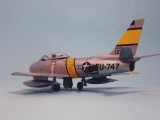
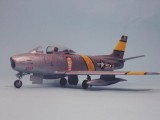
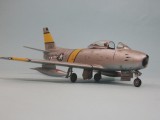
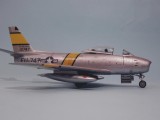
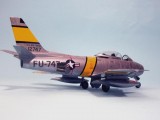
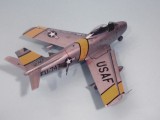
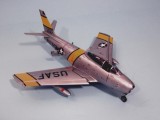
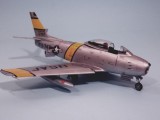
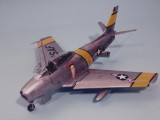
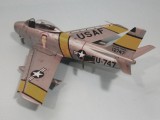
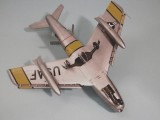
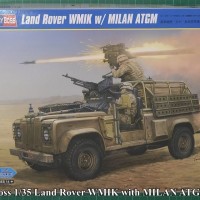

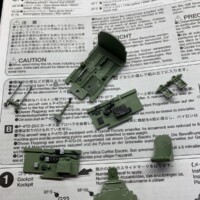
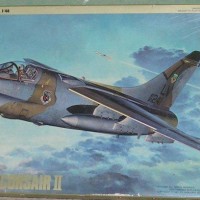
Very sharp, Tom. I see that Kitty Hawk is bringing out a 'K' in 1/32 this year.
Difficult to see the various "hues", but the overall finish looks pretty good.
It's very interesting to tell us the special way you painted this model, and especially what you think of the result, which maybe could be better with old way Alclad method. It's fine result anyway, even if i think photos don't show exactly hues.
I never used Alclad, so i look for modelers who built such good natural metal aircrafts... Congratulations !
I've had [limited] success using the method described herein:
http://imodeler.com/2013/06/nmfs-the-easy-way-2/
Many thanks, Craig, if i follow you well, it's not absolutely Alclad the better metal paint and MM can be even good way for doing natural metallic shades ? Sometimes here in Belgium, i must import liquids products from England or abroad, and it's not authorized by airmail. But i think Alclad and Model master are easy to find here.
You talk about "Future", is it a clear varnish, i dont't know well ?
Sorry to ask so many questions, i've gaps...
"Future" is a clear floor wax...I suppose a clear spray may work as well, but it has a tendency to pull up/lift off when tape is removed. Try to find a product similar to what I described.
Many thanks !
Very convincing NM finish an decal job.
Hats off Tom
Looks great, Tom. Fit/finish right up to your high standards.
Nice one Tom!
Magnus
Greetings :
Nice work on that F-86. To be honest and with all due respect, the pictures shown do make the appreciation of the different hues on the finish very much impossible to admire. But as stated before ... Nice work.
Yeah, they're pretty hard to see in person, which is why I advise against this idea.
Very nice Sabre! Another aviation icon well-rendered. My dad (flew the 100, 101, 105, and F-4) said the one airplane he had always wanted to fly was the 86. (never did in this life - wonder if he was given the chance in heaven...?)
Super build, nice and clean, good story.
Tom,
Great model great write up.